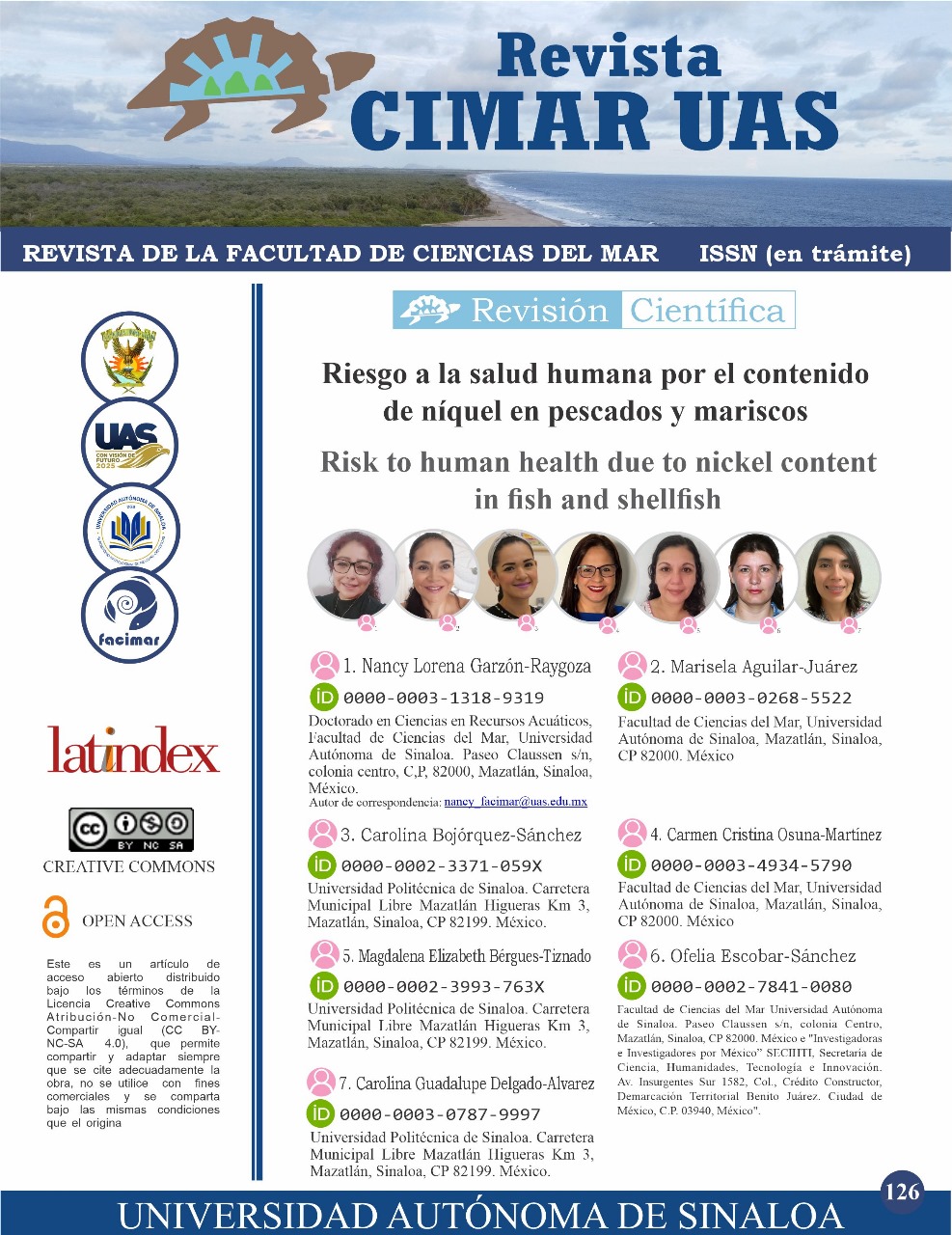Risk to human health due to nickel content in fish and shellfish.
Keywords:
feeding, bioavailability, toxicological riskAbstract
Nickel is a potentially toxic element for humans, and its main source of exposure is food, including vegetables, fish and seafood. This metal is released into the environment by natural and anthropogenic sources. Generally, its components are dispersed in ecosystems and absorbed by sediments or soil particles and can reach bodies of water through runoff. They can also affect humans through food. There is very little background information on the health risks of nickel, which is why it is important to know the bioavailability of this element. Therefore, more studies should be done on this element in food, given its direct relationship with its toxicity to humans.
Downloads
References
AESAN (Agencia Española de Seguridad Alimentaria y Nutrición) (2020). Níquel. Ministerio de consumo. https://www.aesan.gob.es/AECOSAN/docs/documentos/seguridad_alimentaria/gestion_riesgos/FICHA_NÍQUEL.pdf.
Ahmad, M. S., Ashraf, M. (2011). Essential roles and hazardous effects of nickel in plants. Review of Environmental Contamination and Toxicology, 214, 125–167.
Álvaro-Berlanga, S. (2019). Elementos químicos en tejido muscular de tres especies de tiburón, Prionace glauca, Carcharhinus falciformis y Alopias pelagicus en la costa de Manzanillo, Colima, México.
Aristide-Márquez, William-Senior, Ivis-Fermín, Gregorio-Martínez, Julián-Castañeda, Ángel-González (2008). Cuantificación de las concentraciones de metales pesados en tejidos de peces y crustáceos de la Laguna de Unare, estado Anzoátegui, Venezuela. Revista Científica. (Maracaibo) v.18 n.1.
ATSDR (Agency for Toxic Substances and Disease Registry). (2016). Toxicological Profile for Nickel, 397 p.
Ayanda, I. O., Ekhator, U. I., Bello. O. A. (2019). Determination of selected heavy metal and analysis of proximate composition in some fish species from Ogun River, Southwestern Nigeria. Department of Biological Sciences, Covenant University, Ota, Ogun State, Nigeria.
Brouwere, K., Buekers, J., Cornelis, C., Schlekat, C., Oller, A. (2012). Assessment of indirect human exposure to environmental sources of nickel: Oral exposure and risk characterization for systemic effects. Science of the Total Environment, 419, 25–36. doi:10.1016/j. scitotenv.2011.12.049
Castañé P. M., Topalián M. L., Cordero R., Salibián A. (2003). Influencia de la especiación de los metales pesados en medio acuático como determinante de su toxicidad, 20: 13-18.
Dhaneesh, K.V., Gopi, M., Ganeshamurthy, R., Kumar, T. T., Balasubramanian, T. (2012). Bio-Accumulation of metals on reef associated organisms of Lakshadweep archipelago. Food Chemistry, 131, 985–991. doi: 10.1016/j.foodchem.2011.09.097
Dehghani, M., Sana S., Mohammad R. T., Moein, N. (2021). Tracing the heavy metals zinc, lead and nickel in banana shrimp (Penaeus merguiensis) from the Persian Gulf and human health risk assessment. Environmental Science and Pollution Research, 28:38817–38828. https://doi.org/10.1007/s11356-021-13063-w
Doria-Argumedo, C., Sierra, J. (2019). Niveles de metales en el río Ranchería, La Guajira. Revista de la Facultad de Ciencias Básicas, 15: 26-32.
EFSA (European Food Safety Authority). (2006). Tolerable upper intake levels for vitamins and minerals. http://www.efsa.europa.eu/en/ndatopics/docs/ndatolerableuil.pdf.
Eisler, R. (2000). Handbook of chemical risk assessment: health hazards to humans, plants, and animals, three volume set, 1: 739-766.
DOI:10.1201/9780367801397
Forti, E., Salovaara, S., Cetin, Y., Bulgheroni, A., Tessadri, R., Jennings, P., Prieto, P. (2011). In vitro evaluation of the toxicity induced by nickel soluble and particulate forms in human airway epithelial cells. Toxicology In Vitro, 25, 454–461. doi: 10.1016/j.tiv.2010.11.013
Franco-Solórzano, J. G. (2015). Determinación de niveles de mercurio, cadmio, níquel, cromo y plomo en tejido blando, hepatopáncreas en la jaiba azul (Callinectes arcuatus) y sedimento en los ramales del Estero Salado. Universidad de Guayaquil Facultad de Ciencias Naturales Escuela de Biología. Guayaquil, Ecuador.
Frías-Espericueta, M. G., Osuna-López, J. I., Voltolina, D., López-López, G., Izaguirre-Fierro, G., Muy-Rangel M. D. (2008). The metal content of bivalve mollusks of a coastal lagoon of NW México. Bulletin of Environmental Contamination and Toxicology, 80: 90-92. DOI:10.1007/s00128-007-9322-4
Fuentes-Gándara, F., Pinedo-Hernández, J., Marrugo-Negrete, J. (2018). Metales pesados en especies ícticas de la ciénaga de mallorquín, Colombia. Vol. 39 (Nº 03). p. 19
García-Hernández, J., Espinosa-Romero, M. J., Cisneros-Mata, M. A., Leyva-García, G., Aguilera-Márquez, D., Torre-Cosío, J. (2015). Concentración de mercurio y plaguicidas organoclorados (POC) en tejido comestible de jaiba café Callinectes bellicosus de las costas de Sonora y Sinaloa, México. Ciencia Pesquera, 23: 65-79.
González-Dávila, O., Gómez-Bernal, J. M., Ruíz-Huerta, E. A. (2012). Plants and soil contamination with heavy metals in agricultural areas of Guadalupe, Zacatecas, Mexico. Environmental Contamination, 37-50.
Kas, K., Das, S., Dhundasi, S. (2008). Nickel, its adverse health effects and oxidative stress. Indian Journal of Medical Research, 128, 412–425.
Muñoz, A., Costa, M. (2012). Elucidating the mechanisms of nickel compound uptake: A review of particulate and nano-nickel endocytosis and toxicity. Toxicology Applied and Pharmacology, 260, 1–16. doi: 10.1016/j.taap.2011.12.014
Maceda-Veiga, A., Monroy, M., de Sostoa, A. (2012). Metal bioaccumulation in the Mediterranean barbel (Barbus meridionalis) in a mediterranean river receiving effluents from urban and industrial wastewater treatment plants. Ecotoxicology and Environmental Safety, 76: 93-101.
Rodríguez-Heredia D. (2017). Intoxicación ocupacional por metales pesados. Facultad de Ingeniería Química y Agronomía, Universidad de Oriente. Santiago de Cuba, Cuba.
Sadeghi, O., Tavassoli, N., Amini, M M., Ebrahimzadeh, H., Daei, N. (2011). Pyridine functionalized mesoporous silica as an adsorbent material for the determination of nickel and lead in vegetables grown in close proximity by electrothermal atomic adsorption spectroscopy. Food Chemistry, 127, 364–368. doi: 10.1016/j.foodchem.2010.12.159
Schram, S., Warshaw, E., Laumann, A. (2010). Nickel hypersensitivity: A clinical review and call to action. International Journal of Dermatology, 49, 115–125. doi:10.1111/j.1365-4632.2009. 04307.x
USEPA (United States Environmental Protection Agency). (2011). Regional Screening Level (RSL) Summary Table: November 2011. (Available at: http://www.epa.gov/regshwmd/risk/human/Index.htm).

Downloads
Published
Issue
Section
Categories
License
Copyright (c) 2025 Journal Ciencias del Mar UAS

This work is licensed under a Creative Commons Attribution-NoDerivatives 4.0 International License.

 Cada manuscrito está bajo la licencia Atribución-NoComercial-SinDerivadas 4.0 Internacional (CC BY-NC-ND 4.0). Puedes consultar los términos de la licencia en el siguiente enlace:
Cada manuscrito está bajo la licencia Atribución-NoComercial-SinDerivadas 4.0 Internacional (CC BY-NC-ND 4.0). Puedes consultar los términos de la licencia en el siguiente enlace: 